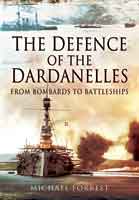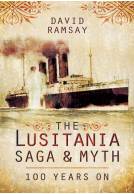The Defence of the Dardanelles (ePub)
From Bombards to Battleships
Imprint: Pen & Sword Maritime
File Size: 7.2 MB (.epub)
ISBN: 9781783469420
Published: 8th November 2012
| Other formats available - Buy the Hardback and get the eBook for free! | Price |
|---|---|
| The Defence of the Dardanelles Hardback Add to Basket | £25.00 |
The Dardanelles Strait, separating Europe and Asia Anatolia, was fortified in the fifteenth century with massive bronze bombards causing any unwelcome ships to run a truly formidable gauntlet. So it proved on 18 March 1915 when a powerful fleet of British and French warships attempted to force a passage to allow minesweepers to clear the Strait. The attack failed at the cost of three ships sunk and three more seriously damaged. The Allied inability to control the Strait necessitated and, crucially, delayed the disastrous Allied invasion of Gallipoli that cost the lives of some 250,000 men.
The author makes an in-depth study of the Turkish defences that caused such loss to the Royal Navy and French allies and reveals that the Ottoman army and Turkey's coastal defences relied almost entirely on the German firm of Krupp for guns. This choice was a crucial element to the successful defence of the Dardanelles. Using excellent illustrations he also examines the relative strengths of the Royal and French Navies and Turkish coastal defences.
This definitive work examines the flaws of Winston Churchill's strategy and identifies the inadequacies of pitting warships against shore fortifications. Damningly, the author's research proves that British intelligence sources had previously assessed that a naval attack alone would not succeed.
Many of the fortifications on the Gallipoli peninsula and the Asian shore are still accessible. The Defence of the Dardanelles helpfully identifies those that can be visited, many of which still have wrecked guns emplaced.
A well-researched study which will enhance the reader's understanding of the disastrous start to the Gallipoli campaign, which cost the lives of one quarter of a million people.
Newsletter of the Western Front Association, Essex Branch - July 2021
There are detailed descriptions of the attempts by the allied navies to reduce the fortifications in 1915 and their eventual failure to break through... Although this is a detailed and comprehensive account, the book is well-structured and very readable.
The Gallipolian
As seen in 'Hampshire Life' magazine.
Hampshire Life
This is a excellent study of this sometimes neglected clash between naval forces and land fortifications, giving a clear idea of why the Allied naval attacks failed, as well as providing a great deal of interesting background on the wider history of the Dardanelles.
History of War
An excellent and very welcome addition to the copious literature on the campaign, making full use of English, French and Turkish sources (published and unpublished) and copiously illustrated with images then and now.
Navy News
Well researched and informative 8/10
The Great War Magazine
Research by English heritage reveals that Walmer Castle was the centre where the 1914-1918 Great War British cabinet made the fatal decision to try to force the Dardanelles Strait.
Terry Sutton
Winston Churchill played a major role in this decision but was also backed up by a number of military leaders, looking for a quick victory.
As a result thousands were killed and the venture proved a nasty defeat for the allies. Just what happened, as a result of the Walmer Castle decision, is the subject of a number of books but Michael Forrest in this work, The Defence of the Dardanelles (Pen and Sword £25), makes an in-depth study of the Turkish defences that kept the Royal Navy at bay. It was in March 1915 that a powerful fleet of British and French warship tried to force a passage through the Dardanelles in bid to help their Russian ally.
Pre-1914 the Turks had forged strong links with the Kaiser’s Germany, who had supplied them with Krupp-manufacturd heavy guns.
This well-illustrated definitive book examines the flaws of Winton Churchill’s plan and argues the inadequacies of trying to pit warships against strong shore fortifications.
It also provides a history of the battles, ashore and afloat, to gain control of the narrow waterway leading to the Black Sea.
The strait has historically provided a bridge between Asia and Europe, going back to the days when Darius I of Persia moved troops across it to support the invasion of Europe around 500 BC.
The author concludes there was poor Allied intelligence about the strength of Turkish fortifications overlooking the Strait and that the flat trajectory ships’ guns were of the wrong type to attack short fortifications.
The chance of overall success by naval bombardment was always very low, contends the author.
The book is interesting and informative. It is well illustrated with both period and contemporary photographs. There are also a number of maps.
The Coast Defence Journal
Major contests between coast artillery and battleships have been few, and this book should prove valuable to those interested in one of the most important.
The book is illustrated throughout with photographs of the existing forts, batteries and guns and concludes with a gazetteers of the existing forts on both sides of the Dardanelles… This is an eminently readable book by an author who has carried out a comprehensive study of the naval attempt to break through the Dardanelles and who has looked at the start of the ill-fated Dardanelles Campaign from a previously neglected viewpoint. Despite its maritime perspective this is definitely a book for all those who are interested in the study of fortifications.
Fortress Study Group
Really good read. Michael Forrest knowns his stuff and knows how to put it over. Hardly aware that I was learning history, which I hated at school.
Peter King
its the best book yet covering this complex story
Customer Review
the account draws on much original,previously unpublished material from the purely naval viewpoint
With the sub-title ‘From Bombards to Battleships’ this admirable book provides first an historical backcloth to the defences along the Dardanelles, commencing with the Persian invasions circa 500BC. Among the numerous illustrations and maps I was amazed to see a picture of the ‘Dardanelles Gun’ a mighty bombard cast in 1464 which now resides in the Royal Armouries Museum, Fort Nelson, Hampshire. It has a bore of 635mm and was capable of firing a 300kg ball up to 1,500m. The main part of the book consists of an in depth study of the fortifications and the events of 1915 in which they played such a key role. The final chapter describing the fortifications today, some still used by the Turkish military. However twenty five batteries are accessible and full details and photographs are provided.
The Bulletin
About Michael Forrest
Michael Forrest is an expert on 19th and 20th Century fortifications. Semi-retired from the aviation industry, he lives at Emsworth, Hampshire.

















